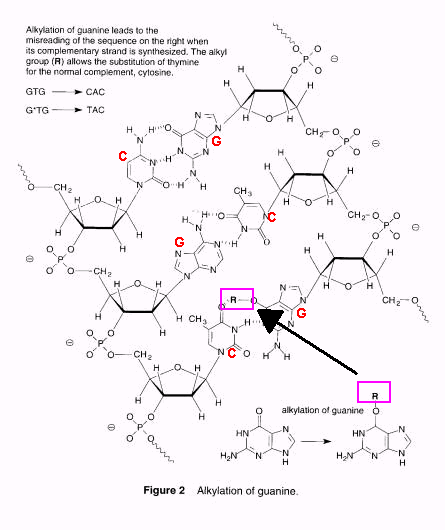
Causes of Cancer
Cancer is a generic term that covers hundreds of different conditions. The clinical manifestation of cancer, a tumor, for example, is clearly the result of cellular proliferation that is out of control. This out-of-control status happened over a period of time, so cancer development is sometimes characterized as having stages. Since cells are controlled by proteins, and proteins are controlled by DNA, we are not surprised to find out that the DNA in cancer cells has been altered in some way. The alterations are called mutations. It is likely, for certain cancers of the intestine it is sure, that 6 to 8 mutations in the DNA have occurred. These mutation are not the same, however, even in clinically similar cancers of the intestine. Apparently there are certain combinations of genes that, when mutated, cause the cells' replication to slip out of control. More on mutations below.
There are a few cancers that are caused by viruses, and some that are genetically inherited. These rare cancers were a hot area of research, on the supposition that other viruses and genes could be found that cause cancer. This research yielded much information about which genes might be responsible for some cancers, but most cancers are not caused by viruses nor genetically acquired.
Cellular replication, mitosis, is held in control by many proteins which are made by many genes. There are feedback control systems within the cell; controls by surrounding cells; chemical messengers from other locations in the body; that all affect these systems. For example, one set of genes prepares the cell to kill itself (called apoptosis), if certain systems in the cell start to get out of control. Other sets of proteins from outside the cell, called growth factors, will instruct the cell to replicate, perhaps to replace damaged tissues. An excess of these factors from outside the cell might cause unwanted proliferation, or a mutation inside the cell might cause a cell to be hypersensitive to external growth factor. Perhaps a mutation will somehow leave the receptor permanently switched-on - constantly telling the cell to replicate. Because keeping cellular replication in close control is so important for higher organisms, there may be several redundant systems that must be disabled before replication slips out of control. The notion that cancer could be controlled by understanding these aberrant genes and proteins is an important field for cancer research. Certain genes, usually known by a three letter designation, all lower case and in italics, like ras or src,have been implicated in cancer processes. Of course sooner or later, variants of these genes are found so the name gets longer, ras-1, etc.
So how do mutations arise? For one method, let's go back to that awful picture

What is shown here is a flat representation of DNA. The phosphate groups are outboard, the sugars next, and the interior shows the nitrogenous bases, cytosine(C), and guanine(G) (there are two other bases in DNA, adenine (A)and thymine(T)). The bases are heterocycles with nitrogen and oxygen atoms, both of which have some electrons to give away. If a chemical that would like some electrons (an "electrophile") were to make its way to the base, a chemical reaction could take place. The pictures on the lower right seems to show the guanine as floating in space, but in fact it is attached to the sugar. The "R" could be any organic, hydrocarbon-type molecule. Once attached to the DNA, we refer to the R as an "adduct." The upper pictures show the R attached to the guanine, in the middle of the DNA molecule. What happens next?